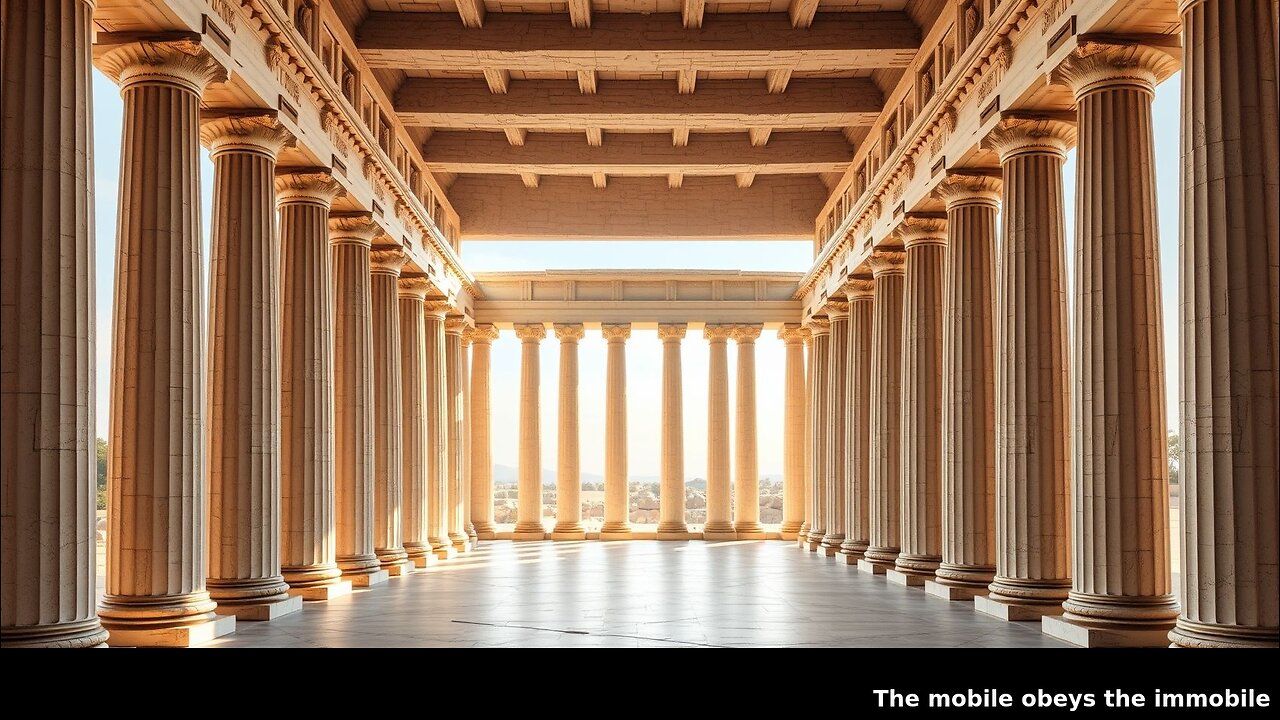Premium Only Content

The Nordic-Aryan Essence of Ancient Rome: A Study of the Roman Soul and Race
Title: The Nordic-Aryan Essence of Ancient Rome: A Study of the Roman Soul and Race
Tags: #Evola #AncientRome #NordicAryan #RomanSpirit #Traditionalism #HyperboreanRace #RomanVirtues #AryanHeritage #SpiritualRace #RomanTradition
1. Nordic Essence in the Roman Senate: The Roman Senate, particularly during the Republican era, was characterized by a Nordic essence—enlightened audacity, dominated attitude, concise speech, and a bold sense of domination. This Nordic spirit was prevalent among the Patriciate and the nobilitas, embodying the true Roman as a Nordic incarnation.
2. Ethical Virtues of the Nordic Imprint: The Roman model emphasized ethical virtues such as virility, virtus, courage, fortitude, wisdom, self-formation, discipline, dignity, gravitas, and pietas. These virtues were seen as specifically Roman and were integral to the Nordic-Aryan soul.
3. Greek Testimony to Roman Royalty: Early Greek ambassadors to Rome were struck by the Roman Senate's regal demeanor, describing it as an "assembly of kings." This reflected the inner sense of royalty, clarity, dignity, and audacity that defined the highest race of Rome.
4. Artistic Depictions of Roman Types: Roman art, particularly statues, reveals the Nordic-Aryan force of Roman origins. While some idealization is present, it aligns with the historical and human reality, reflecting the soul and vocation of the Roman race.
5. Caesar and the Sidereal Quality: Julius Caesar embodied the "sidereal" quality of the Nordic-Aryan race, with a cold, hard splendor and a remote, uranic essence. His lineage was associated with the sacredness of kings and the dignity of gods, reflecting the Hyperborean race's highest essence.
6. Augustus and the Solar Race: Augustus, with his light-colored eyes and blond hair, represented the "solar race." His connection to Apollo, the Hyperborean god of light, symbolized a return to the golden age of the primordial solar civilization.
7. Imperial Roman Types: Various imperial figures, such as those with Aryo-Roman traits, displayed a solemnitas and virility that reflected the Roman sense of limit and auctoritas. These types maintained the active race's spirit, even as the Nordic element became more pronounced.
8. Decadence and Heterogeneity: In later periods, the Roman race showed signs of decadence, with the emergence of heterogeneous types influenced by Eastern and telluric races. Despite this, the sacred-imperial idea persisted, as seen in leaders who upheld Roman dignity until death.
9. Aphroditisation of Nordic Traits: The degeneration of the Nordic-Aryan race is evident in the "aphroditisation" of Roman types, where pure Nordic traits were overshadowed by effeminate and Dionysian influences, particularly in art and depictions of historical figures.
10. Relativity of Physical Race: The purity of the physical race is relative to the overall spiritual essence. While some Roman types retained Nordic traits, their spiritual race could be influenced by various factors, leading to a loss of inner style and precise spiritual race.
ANCIENT ROME
In the Senate during the Republican era and from the fifth to the first century BCE, the Nordic essence was consistently seen as the dominant and restraining force. This was characterized by enlightened boldness, a controlled demeanor, concise and composed speech, well-considered decisions, and a bold sense of authority. Within senatorial families, particularly among the Patricians and later the nobilitas, the concept of the true Roman emerged as a distinct incarnation of Nordic nature. This ideal Roman embodied ethical virtues of Nordic origin: masculinity (virtus), courage, fortitude, wise reflection, self-discipline, dignity (gravitas), respect (pietas), and a measured solemnity (solemnitas), which senatorial families regarded as uniquely Roman.
These observations come from a well-known German racial theorist discussing the "soul race" of ancient Romans. The term "Nordic" here should be understood with the caveats previously outlined. Early Greek accounts of Rome support this view, as Greek ambassadors to the Roman Senate, expecting to encounter barbarians, instead found themselves in the presence of what they described as "an assembly of kings." This reflects a style of leadership rooted in inner strength, clarity, dignity, and audacity—hallmarks of the highest Roman "soul race." These traits are evident not only in written records but also in surviving statues and depictions.
Examples of ancient Roman figures, highlighting the Nordic-Aryan essence of their origins. While artistic idealization must be considered, such idealization often aligns with historical reality and reflects the ideals and soul of a race. Both historical and legendary figures provide valuable insights into the inner character of a people.
Julius Caesar represents a higher manifestation of this spirit. His self-description as possessing the sacredness of kings and the dignity of gods reflects his sense of belonging to a superior spiritual race. His "sidereal" gaze, associated with the Hyperborean race, symbolizes the cold, distant brilliance of ancient Rome.
Augustus, with his light-colored eyes and blond hair, reflects a stronger Nordic element. His connection to Apollo, the Hyperborean god of light, and the perception of his reign as a return to a "golden age" underscore his alignment with the solar race.
The decline of Roman types is evident in figures like Caesar’s greatest adversary, who embodies Italic racial elements distinct from the Aryan core of Rome.
The relativity of physical racial purity is illustrated by certain Hellenic and Roman depictions, where Nordic traits are overshadowed by decadent, effeminate qualities, as seen in some representations of Apollo.
In summary, the Nordic-Aryan essence was a defining force in ancient Rome, shaping its ideals, leadership, and cultural expressions, even as later influences and decadence altered its manifestations.
Metaphysical part:
The opposition between the Semitic spirit and the Aryan spirit lies at the core of anti-Semitism. However, to gain true understanding, we must move beyond vague racialist notions or a purely negative definition of "Aryan" as simply "non-Jewish." Instead, we must define "Aryanity" as a positive, universal concept, contrasting it with Semitic civilization, particularly Jewish civilization, in terms of divinity, cults, religiosity, and worldview. This requires elevating the 19th-century ideas of philologists and historians, especially those of Max Müller’s school, regarding the fundamental unity of Indo-Germanic civilizations, religions, symbols, and myths. These ideas must be seen in a new light, beyond their naturalistic interpretations, and connected to Wirth’s theories of a pre-Nordic, Hyperborean primordial civilization as the origin of later Indo-Germanic cultures. Additionally, Bachofen’s insights into the antagonism between "solar" (Uranic) and "lunar" (Telluric) civilizations, and between societies governed by masculine and feminine principles, remain crucial.
In our previous work (Revolt Against the Modern World), we explored these themes in depth. Here, we summarize the conclusions, focusing on the "Aryan" or "solar" spirituality, which stands in antithesis to the Semitic spirit. The Arya (a Sanskrit term for "noblemen," referring to both blood and spirit) embodied an affirmative attitude toward the divine. Their mythological symbols reflected a sense of "incorporeal virility of light" and "solar glory," representing a victorious spiritual virility. They believed in a super-human race of immortals and divine heroes, often attributing to them superiority over supernatural forces. The Aryan ideal was more royal than sacerdotal, emphasizing transfiguring affirmation over religious abandon, ethos over pathos. Kings were also priests, possessing a mystical force tied to their race’s fortune and the efficacy of rites, which were seen as objective operations on supernatural forces. The concept of Regnum was sacred and universal, from the Indo-Aryan Cakravarti to the Roman Aeternitas Imperi and the medieval Sacrum Imperium.
Aryan spirituality emphasized rites as compelling operations toward the divine, with heroes, rather than saints, occupying the highest places of immortality (for example, Valhalla, the Isle of the Blessed, Indra’s sky). Unlike the Semitic myth of Adam’s fall, Aryan myths celebrated heroes like Hercules, Jason, Mithras, and Sigurd, who achieved immortality. The Aryan ideal was "Olympian," representing unchanging, perfect essences, in contrast to the Semitic gods, who were subject to birth, death, and rebirth. The Aryan symbol was solar, embodying purity and strength, while the Semitic symbol was lunar, reflecting external light. Ethically, the Aryan spirit valued freedom, personality, loyalty, and honor. Aryans prized independence and difference, yet they obeyed leaders with pride, bound by freely established ties. This ethos was reflected in terms like Bhakti, fides, Trust, and Treue, which underpinned feudal systems. In Mithraic communities, brotherhood was rooted in virile solidarity, while ancient Persians dedicated their thoughts and deeds to transcendent leaders. In India, the caste system was based on spiritual loyalty (Dharma and Bhakti). The Aryan spirit was characterized by self-control, clarity, and an "Olympian" ideal of divine and heroic super-humanity, alongside loyalty and honor.
-
 LIVE
LIVE
Wendy Bell Radio
5 hours agoPet Talk With The Pet Doc
6,466 watching -
 UPCOMING
UPCOMING
Michael Franzese
10 hours agoMenendez Brothers Denied Parole – Newsom Holds Their Fate
16.9K3 -
 40:42
40:42
SouthernbelleReacts
1 day ago😂 American Pie (1999) Reaction | Iconic Teen Comedy, High School Chaos & 90s Nostalgia 🥧
361 -
 24:06
24:06
True Crime | Unsolved Cases | Mysterious Stories
5 days ago $0.11 earnedShe Traveled Alone… and Never Came Back – 5 Mysterious Unsolved Cases (Part 6)
1271 -
 27:23
27:23
Clickbait Wasteland
13 hours agoAsking New Yorkers Who They Support For Mayor: Staten Island
491 -
 16:58
16:58
World2Briggs
21 hours agoThe California Rant: Point Blank With No Fluff or BS. California Gold?
198 -
 17:49
17:49
Chris Harden
1 day ago $0.01 earnedThe Glass Capital That Shattered | The Decline of Streator, Illinois
8 -
 51:15
51:15
JohnXSantos
3 days agoClothing Brand Manufacturers + Winners
191 -
 10:06
10:06
Cyclops Videos Joe W Rhea
12 days agoHybrid Super 22 Rifle
67 -
 8:30
8:30
Millionaire Mentor
20 hours agoMaria Bartiromo Plays Clip That DESTROYS Adam Schiff’s Entire Story
85